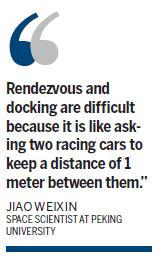Launch to pave way for space station
Updated: 2011-09-21 07:35
By Xin Dingding (China Daily)
|
|||||||||||
Tiangong-1 will blast off next week to conduct key docking experiments

BEIJING - China will launch an unmanned module next week, paving the way for a planned space station, a spokesman for the space program said on Tuesday.
Tiangong-1, or "Heavenly Palace 1", will blast off from Jiuquan Satellite Launch Center in Gansu province between Sept 27 and 30, the spokesman said.
The 8.5-ton module, and the Long March II-F rocket that will carry it skyward, were positioned onto the launch pad on Tuesday, signaling that the project has entered the final preparation stage.
"Scientists will conduct final tests in the next few days before injecting propellants for the launch," Cui Jijun, director of the Jiuquan Satellite Launch Center, said.
The program spokesman said that Tiangong-1 will serve as "a target spacecraft" for rendezvous and docking experiments.
It will also work as "a platform to test long-term unmanned and short-term manned operations", he said.
Technical and medical experiments will provide crucial data ahead of the building of the space station (scheduled for 2020).
Three rendezvous and docking experiments will be conducted.
An unmanned Shenzhou-VIII craft will be launched later this year to dock with Tiangong-1. In 2012, Shenzhou IX and Shenzhou X will blast off to complete at least one manned docking.
Jiao Weixin, a space scientist at Peking University, said that rendezvous and docking - vital maneuvers for manned programs - are hard to master.
"Rendezvous and docking are difficult because it is like asking two racing cars to keep a distance of 1 meter between them," he said.
The mission requires two craft, traveling at speeds of 28,000 km/h, to enter the same orbit and connect with precision, he said.
The China Manned Space Engineering Office rescheduled the launch of Tiangong-1 after the failed launch of an experimental orbiter last month.
The spokesman said that the carrier rocket to blast off with Tiangong-1 atop has been modified.
Only the United States and Russia have mastered rendezvous and docking technology, said Pang Zhihao, deputy editor-in-chief of the magazine Space International.
Spacecraft developed by Europe and Japan have utilized US and Russian technology to dock with the International Space Station, he added.
Related Stories
Chinese orbiter fails to enter designated orbit 2011-08-19 06:34
China launches 9th orbiter for global navigation 2011-07-27 08:57
Moon orbiter Chang'e-2 goes to outer space 2011-06-09 19:19
Hot Topics
Organ transplant bonds mother and son
Editor's Picks

|

|

|

|

|

|







